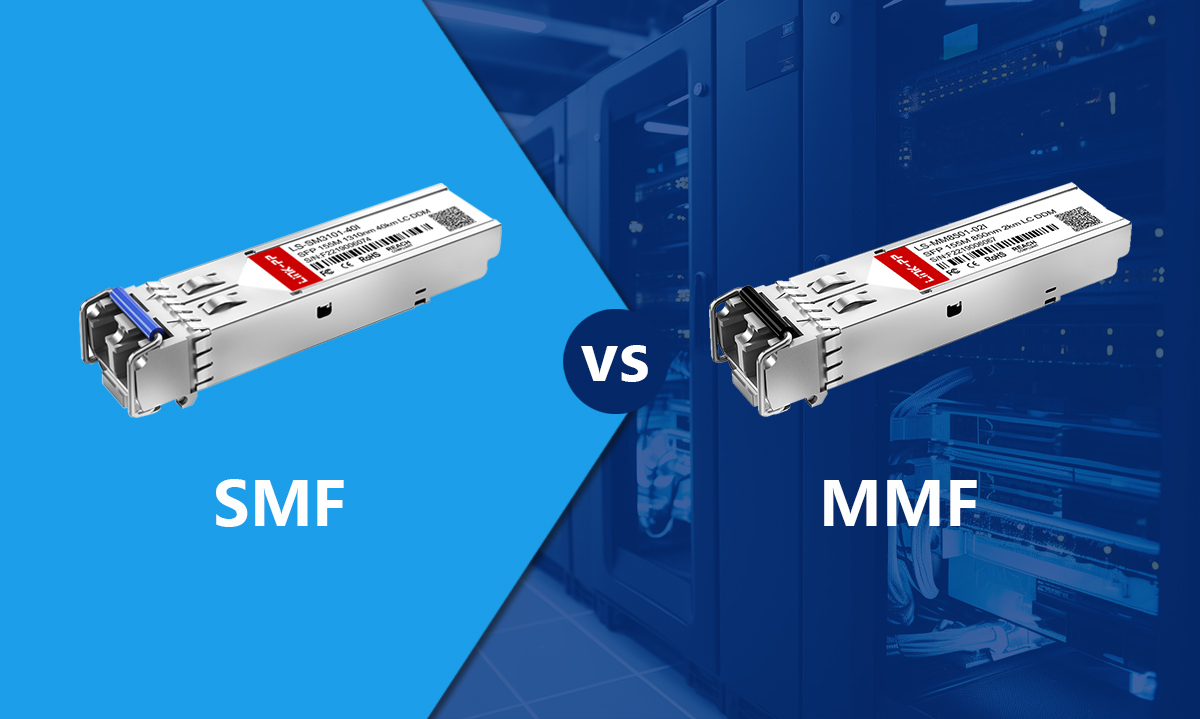
When choosing between single-mode optical modules and multi-mode optical modules, understanding their distinctions is crucial. These modules vary in core size, transmission distance, speed, cost, and application. Whether you are in need of single-mode optical modules for lines that require high transmission rates and long distances, or multi-mode optical modules for short-distance transmission scenarios with numerous network nodes and connectors, you can find the optical modules you desire at the LINK-PP online mall.
Type & Core Diameter of Single Mode and Multimode Fiber
Parameter | Single-Mode Modules | Multimode Modules |
|---|---|---|
Fiber Standard | OS1/OS2 | OM1/OM2/OM3/OM4/OM5 |
Core Diameter | 9-10/125µm | 50/125µm or 62.5/125µm |
Color Coding | Yellow (OS2), Blue (OS1) | Orange (OM1/OM2), Aqua (OM3/OM4), Lime (OM5) |
📌 Key Insight:
Single-mode fibers have a narrower core, reducing modal dispersion for long-haul transmission. Multimode fibers allow multiple light paths, optimizing short-range connectivity.
Wavelength & Light Source
Wavelength
The operating wavelength of single-mode optical modules is generally 1310nm or 1550nm.
The operating wavelength of multi-mode optical modules is usually 850nm, and 1310nm is also used in some cases.
Light source
Single-mode optical modules use LD (Laser Diode) or LEDs with a narrow spectral line as the light source.
Multi-mode optical modules use light-emitting diodes or lasers as the light source.
Distance Capabilities of Single-Mode and Multimode Optical Modules

Transmission Range of Single-Mode Optical Modules
Single - mode optical modules are used for long - distance transmission, generally over 10km, and can reach 150 - 200km. LINK-PP LS-SM3110-20I SFP+ 10GBASE-LR SMF Optical Transceiver Module can send data over 20 kilometers easily. In some cases, they can even reach 150 to 200 kilometers without losing much signal. This makes them perfect for big networks like telecommunication systems.
Benefits of single-mode fiber for long distances:
Low signal loss due to its small core.
Works with laser light for accurate data transfer.
Reliable for distances up to 200 kilometers.
Transmission Range of Multimode Optical Modules
Multi-mode optical modules are used for short-distance transmission, generally no more than 2km, usually in the range of several hundred meters to several kilometers, and are often used for transmissions within 300 - 500m. LINK-PP Multimode optical modules work best within 300 to 500 meters. If your network is in a small area, multimode modules are a smart and affordable choice.
Benefits of multimode fiber for short distances:
Affordable for short-range use.
Handles lots of data in small areas.
Great for places with many connections, like data centers.
Tip: Think about distance when picking between single-mode and multimode modules. Single-mode is best for long distances, while multimode works better for short ranges.
Application scope 🖥️
Single-mode: Single-mode optical modules are mostly used in lines with high transmission rates and long distances, such as telecommunication networks, cable TV networks, metropolitan area network construction, long-haul trunk transmission, passive optical networks, etc. They are also widely used in the connections between data centers.🌐
Multimode: Multi-mode optical modules are mostly used in short-distance transmission scenarios with many network nodes and connectors, such as data center computer rooms and local area networks. 🏭
Connector type
Single-mode optical modules usually use small-sized connectors such as LC or SC.
Multi-mode optical modules usually use larger-sized connectors such as ST or SC.
Cost and price💰
Single-mode optical modules use more components and the laser light source is more expensive, so the overall cost is high, and the price is much higher than that of multi-mode optical modules. 📈
The manufacturing process of multi-mode optical modules is relatively simple, so the cost is lower. 📉
Power consumption
Generally, the power consumption of single-mode optical modules is greater than that of multi-mode optical modules. However, the specific power consumption is also affected by factors such as the parameters, models, and brands of the optical modules. There may also be cases where single-mode and multi-mode optical modules with different parameters, models, and brands have the same power consumption.
Compatibility 🔄
Single-mode devices: Can operate on both fiber types (with potential performance issues on MMF) ↔️
Multimode devices: Only work with multimode fiber ↕️
FAQ
1. What is the main difference between single-mode and multimode optical modules?
Single-mode modules have a small core (9-10 µm) for long distances. Multimode modules have a bigger core (50–62.5 µm) for short ranges. Single-mode works better for high speeds and far distances. Multimode is cheaper and good for short connections.
2. Which optical module should you choose for a data center?
Multimode modules are best for short distances in data centers. They are affordable and work well for nearby connections. For long-distance links between facilities, single-mode modules perform better.
3. Can single-mode modules work with multimode fibers?
Yes, single-mode modules can work with multimode fibers. However, the performance might not be as good. To get the best results, use the right module with the matching fiber.
4. Why are single-mode optical modules more expensive?
Single-mode modules cost more because they use advanced lasers. Making them also needs precise engineering. They handle long distances and fast speeds, which makes them worth the price.
5. What is modal dispersion, and why does it matter?
Modal dispersion happens in multimode fibers when light beams arrive at different times. This causes delays in signals. It limits how far and fast data can travel, so multimode fibers are not good for long distances.




